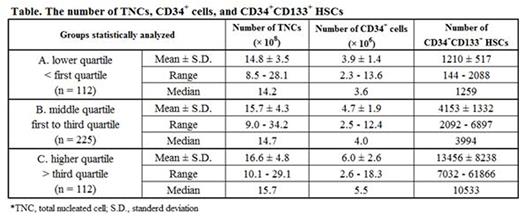Abstract

Background. Over the past two decades, the fields of umbilical cord blood (UCB) banking and UCB transplantation (UCBT) have been established. Over 600,000 UCB units have been stored for UCBT world-wide, and over 30,000 UCBTs have already been performed. In Japan in particular, the number of UCBTs has rapidly increased, and over 11,000 UCBTs have been performed thus far. However, UCBT is often associated with delayed neutrophil and platelet recovery compared with bone marrow transplantation. Furthermore, a major obstacle to overcome in UCBT is engraftment failure, which can often be a life-threatening complication. There are several factors influencing graft failure, including the numbers of total nucleated cells (TNCs) and CD34+ cells, the degree of HLA disparity, the presence or absence of anti-HLA antibody, and inappropriate immune suppression before UCBT. Among these factors, the numbers of TNCs and CD34+ cells have been used as dependable factors for selecting UCB units for transplantation. However, whether or not both factors can be used as reliable indices of the HSC activity of UCB units remains to be confirmed.
Aim. In order to evaluate the quality of UCB units for UCBT, we quantified the actual numbers of transplantable CD34+CD133+ HSCs residing in UCB units.
Materials and Methods. We previously identified CD133 as a positive marker of human CB-derived CD34+/- SCID-repopulating cells (SRCs) (Leukemia 28:1308,2014). CB-derived 18Lin-CD34+/-CD133+/- cells were sorted by FACS, and the HSC capacities of these four fractions of cells were extensively investigated. All of the mice that received 18Lin-CD34+/-CD133+ cells showed primary and secondary human CD45+ cell repopulations. However, none that received 18Lin-CD34+/-CD133- cells showed any human cell repopulation. These results showed that the CD133 expression clearly segregated SRC activities into the positive fractions. Furthermore, a limiting dilution analysis demonstrated that the frequencies of SRCs in the 18Lin-CD34+/-CD133+ fraction were 1/99 and 1/142, respectively. Based on these data, we developed a new method for accurately measuring the numbers of transplantable CD34+/- CD133+ SRCs residing in UCB units.
Results. We measured the numbers of transplantable CD34+CD133+ SRCs (HSCs) residing in 449 UCB units. The numbers of TNCs ranged from 8.5 to 34.2 x 108 (median, 14.9 x 108) and the numbers of CD34+ cells ranged from 2.3 to 18.3 x 106 (median, 4.1 x 106). Surprisingly, the numbers of CD34+CD133+ HSCs showed an unexpectedly wide range from 144 to 61,866 (median, 3,994). These results clearly demonstrated that the HSC number varied widely among UCB units. Next, we statistically analyzed the HSC numbers of each UCB unit using quartile deviation. The data were divided into three groups based on the HSC quartiles: the lower group (A) including the data under the first quartile, the higher group (C) including data above the third quartile, and the middle group (B) including everything in between. The Pearson and the Spearman correlation coefficients between the HSC number and TNCs or CD34+ cells were calculated for each group. As shown in the Table, the respective numbers of TNCs and CD34+ cells ranged from (A) 8.5 to 28.1 x 108 (median, 14.2 x 108) and 2.3 to 13.6 x 106 (median, 3.6 x 106), (B) 9.0 to 34.2 x 108 (median, 14.7 x 108) and 2.5 to 12.4 x 106 (median, 4.0 x 106), and (C) 10.1 to 29.1 x 108 (median, 15.7 x 108) and 2.6 to 18.3 x 106 (median, 5.5 x 106). In contrast, the numbers of CD34+CD133+ HSCs ranged widely: (A) 144 to 2,088 (median, 1,259), (B) 2,092 to 6,897 (median, 3,994), and (C) 7,032 to 61,866 (median, 10,533). Except for (C), the Pearson and the Spearman correlation coefficients were close to zero, showing no correlation between the numbers of CD34+CD133+ HSCs and the numbers of TNCs and CD34+ cells.
Conclusion. These results strongly suggest that the numbers of TNCs and CD34+ cells do not represent the numbers of CD34+CD133+ HSCs residing in the UCB units. A prospective clinical observation study is now ongoing to investigate the correlation of the numbers of CD34+CD133+ HSCs and the clinical indexes, including neutrophil and platelet recovery as well as graft failure after UCBT. We anticipate that the numbers of CD34+CD133+ HSCs residing in UCB units may be useful as a new indicator for quality assurance of UCB units.
No relevant conflicts of interest to declare.
Author notes
Asterisk with author names denotes non-ASH members.

This icon denotes a clinically relevant abstract


This feature is available to Subscribers Only
Sign In or Create an Account Close Modal